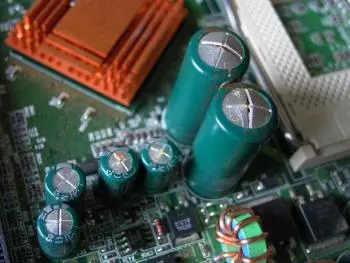
Capacitors are electronic devices that play a crucial role in modern electronics. Within the wide variety of capacitors available on the market, electrolytic capacitors (or electrolytic capacitors) are particularly important due to their unique characteristics and versatility in applications requiring energy storage and signal filtering.
In this article, we will explain in detail electrolytic capacitors, their operation, types, common applications and key considerations for their use in electronic circuits.
What is an electrolytic capacitor?
A capacitor is a passive electronic component that stores energy in the form of an electrical charge. Electrolytic capacitors are a variant of conventional capacitors, which use a metal oxide layer as a dielectric.
These capacitors are characterized by their liquid dielectric, usually an electrolyte solution, which provides a high energy storage capacity compared to other types of capacitors.
Structure of an electrolytic capacitor
 The basic structure of an electrolytic capacitor consists of two conductive plates, which are usually aluminum sheets, separated by a layer of dielectric. The dielectric is a thin film of aluminum oxide, and the electrolyte solution is impregnated in this film.
The basic structure of an electrolytic capacitor consists of two conductive plates, which are usually aluminum sheets, separated by a layer of dielectric. The dielectric is a thin film of aluminum oxide, and the electrolyte solution is impregnated in this film.
A distinctive feature of electrolytic capacitors is their polarity, which means they must be connected in the correct direction in a circuit.
Basic operation
When a potential difference (voltage) is applied across an electrolytic capacitor, the positively and negatively charged conducting plates accumulate opposite charges on their surfaces.
The oxide film acts as an insulator that prevents charges from flowing between the plates, resulting in the buildup of electrical energy in the capacitor. This energy is stored in the form of an electric field between the plates.
When the voltage source is disconnected, the capacitor maintains its stored charge.
Examples of common applications
Electrolytic capacitors play a crucial role in a wide range of electronic applications.
Some examples of the most common uses include:
- Power Supplies – Used in filtering and energy storage stages in linear and switching power supplies to provide stable output voltage and reduce noise.
- Audio and amplification : In audio circuits, these capacitors are used to couple audio signals, block unwanted DC components, and stabilize amplifiers.
- Motor Ignition and Starting : Electrolytic capacitors are used in electric motor starting applications, such as air compressors and single-phase motors, to provide the torque necessary to initiate motion.
- Voltage regulation : In voltage regulation applications, electrolytic capacitors can smooth out voltage fluctuations, thereby improving the stability of circuits.
- Timing Circuits : Used in timing circuits to control the duration of events and delays, which is essential in applications such as stopwatches and delay timers.
Key considerations
When working with electrolytic capacitors, it is essential to keep some key considerations in mind to ensure their optimal performance and safety:
- Polarity: Due to their polarity, electrolytic capacitors must be connected in the correct direction in a circuit. The terminal with the band or mark usually indicates the negative terminal.
- Maximum voltage: The maximum voltage specified on the capacitor should not be exceeded, as this may cause failure and, in some cases, rupture.
- Lifespan and Temperature: The lifespan of an electrolytic capacitor can be affected by temperature. It is important to operate them within their specified temperature range.
- Ripple and ESR: Ripple and equivalent series resistance (ESR) are important parameters to consider when selecting electrolytic capacitors for filtering applications.
- Size and space: Electrolytic capacitors can take up considerable space on a printed circuit board. Size and layout must be considered in the circuit design.